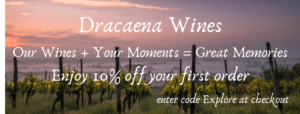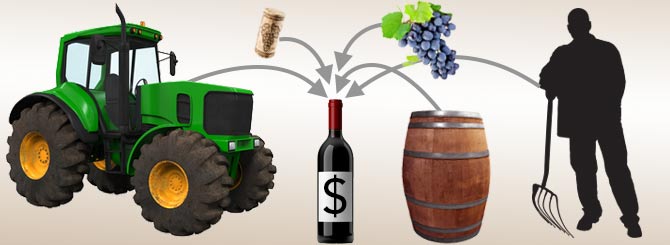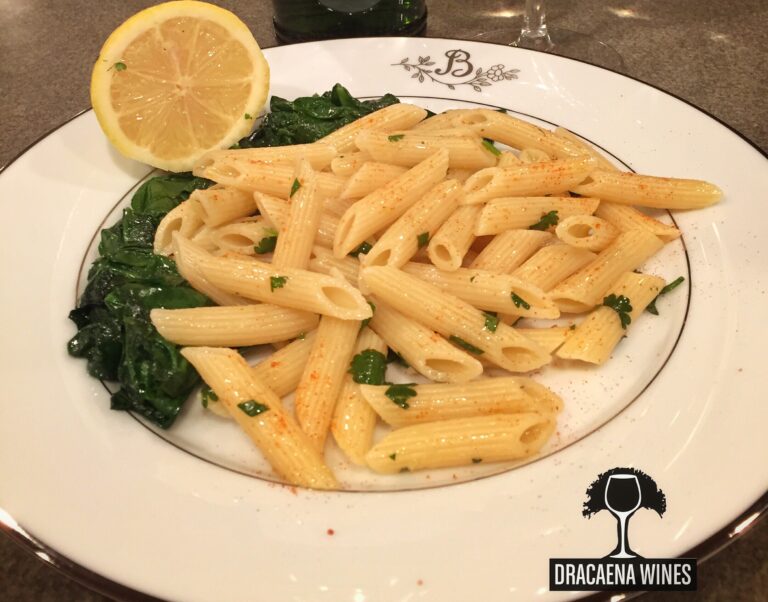I had the privilege of being invited to a press trip to Jumilla, Spain. I happily accepted and once in Spain, it was love at first sight. (and taste) Jumilla, located southeastern portion of Spain has approximately 22,000 hectares of land under vines. The region is small; with only 39 registered wineries. Thanks to their soil type, many vineyards were not effected by Phylloxera, and the region boasts many vines that are over 90 years old and planted to their original rootstock.
I have been told that I do not do anything half-way. For me, it is 100% or 0%; there is no in between. While in Jumilla, I already knew I was going to be attending another press trip to Spain. This time to Navarra. The region located in northern Spain and part of the Basque Country and the Ebro River Valley. I decided that I was going to refresh my Spanish skills so that I could speak the language when I returned. I downloaded Duolingo (which is a pretty awesome app) and I have been practicing my Spanish daily for just under one year! And it worked. When I went to Navarra, I was able to understand a lot more of what the winemakers were saying when speaking in their native language.
 But what truly came clear to me when I was in Navarra was how much I loved Spanish wine. I became enamored with not only the wines, but with the regions that produced them. And then it happened. A little voice in my head kept saying, “Take the Spanish Wine Scholar class!” At first I ignored the voice, but it kept getting louder and louder. So I did a little research on the Wine Scholar Guild website.
But what truly came clear to me when I was in Navarra was how much I loved Spanish wine. I became enamored with not only the wines, but with the regions that produced them. And then it happened. A little voice in my head kept saying, “Take the Spanish Wine Scholar class!” At first I ignored the voice, but it kept getting louder and louder. So I did a little research on the Wine Scholar Guild website.
Being completely honest, the first time I looked, I said no way. The cost is significant. ($950 for the instructor led program) You have the option to do the class through independent study for $750. I sat and stared at the website for a bit and decided against signing up. But the voice kept calling to me and every time I opened a bottle of Spanish wine, I would be curious about the autonomous region it came from. After a bit of mulling, I decided I indeed wanted to learn about the country and its wines; so I signed up.
I chose the instructor led option. This option includes 10 weeks of online video sessions with Rick Fisher. If you are not familiar with him, you are missing out. He is so knowledgeable and honestly just a great guy. In my opinion, having an actual instructor help me go through the information was well worth the price. I was right.
In order to help you study for the class, you receive a study manual that is 300+ pages, online study modules and ten live webinars. The program is arranged so that you travel your way through the each of the seventeen autonomous regions, learning the climactic influences and primary wines produced in each. We began in the north west region of Galicia; traveled through the northern regions towards the east. We then moved down the east coast of Spain, followed by the middle and ultimately ending with the islands. The final session was a cumulative review to prepare us for the exam.
Each webinar was approximately an hour long and was recorded in case you were not able to make the session. Through the wine scholar guild’s website, you have access to learning objectives, learning modules quizzes, flash cards and mini quizzes for each autonomous region. Another benefit was the pronunciation exercises as well as the downloadable maps.
How I Approached the Class
The first thing I did was put the class schedule into my calendar. I wanted to make sure that I did not double book myself. The benefit of having the instructor led class were these webinars and I wanted to attend them in real life, versus watching the recordings. My concern was if I had a question about the information, I wanted the ability to be able to ask it and receive an immediate response.
The second thing I did was to make sure I had a second computer screen set up. This way I could watch the webinar and take notes at the same time. I actually can type faster than I write and although notebooks are great, they are easily misplaced. The added benefit to taking digital notes is that wherever I am, I have the notes with me. If I find a few free moments to review the information, it is easily accessible.
Additionally, I tried my best to read the chapters that were being covered prior to the webinar. This didn’t always work out and I noticed a big difference between what I got out of the webinar when I read vs. when I didn’t. You are provided with learning objectives for each chapter. I read these before I read the unit so that I could focus on what I needed to learn and didn’t dwell on topics that were not going to be on the exam. I highlighted the main points in each unit.
At the beginning of each webinar, Rick provided five review questions from the previous unit. I made sure I copied down these questions as well as the questions that were asked within the online learning module quizzes.
Prepping for the Test
One word… well two…. Flash Cards! I use an app called Quizlet. I created flashcards for everything and broke them up into different groups. I created a set for each of the seventeen autonomous regions. In the end, I had over 900 flash cards. Additional sets included:
~ Aging Specs: Spain has very specific regulations for aging their wines. These regulations determine if a wine a designated as Joven, Crianza, Reserva or Gran Reserva. However, certain autonomous regions, such as Rioja, Cava, and Ribera del Duero, have their own classifications.
~Autonomous Groupings: Several of the autonomous regions are grouped together. For example; Green Spain includes Galicia, Cantabria, Asturias and Pais Vasco. I took the larger groupings and made sure I knew which autonomous regions were found within it.
~DO and grape varietal match: In this set, I matched the autonomous region with its most popular red and white (or rosé) varietal. For example DO Penedes is known for the production of Xarello and Ull de Llebre (Tempranillo.)
In Addition to Flash Cards
~I rewatched all the videos and took notes again. Since it was the second time through, I was able to take more elaborate notes and able to connect more dots between the regions and how they are effected by the rivers, mountains and soils.
~Charts: I made charts to allow me to see the information in a different format. For my learning style, charts are easier for me to see connections and the Spanish Wine Scholar program expects you to understand the region in depth, not just data points. Rick mentioned over and over that we need to understand the why and how of the regions. Below is the chart I created for the must know subzones.
| DO | Subzone | Characteristics | |
| Green Spain | Rias Baixas | Val do Salnes | Oldest; largest; coldest; most production; birth of Albarino; flattest; wettest |
| Rias Baixas | Condado do Tea | Warmest; southern most 20% production | |
| Rias Baixas | O’Rosal | Known for blends rather than varietals; southwestern most | |
| Rias Baixas | Ribeira Do Ulla | youngest, located north east, driest region. Fuller body wines; northernmost | |
| Rias Baixas | Soutomaior | center chosen to only produce Albarino – only about 6 producers; smallest | |
| La Rioja | Rioja DOCa | Rioja Alavesa | Entirely in Pais Vasco; smallest |
| Rioja DOCa | Rioja Alta | Most vineyard area, entirely in La Rioja | |
| Rioja DOCa | Rioja Oriental | Partially in La Rioja and partially in Navarra, largest in size but not vineyards; only subzone not Tempranillo (Garnacha Tinta) | |
| Ebro River Valley | Navarra | Tierra Estrella | Most eastern; cooler; highest; tinto and rosado; clay soils, Tempranillo |
| Navarra | Valdizarbe | North central; closest to mountains; marl soils; all 3; most diverse: most humid Tempranillo | |
| Navarra | Baja Montana | North eastern; marl soils; rosado; directly under Pyrenees; Tempranillo | |
| Navarra | Ribera Alta | Largest; biggest diurnal ; loam; centrally located; tinto; Tempranillo | |
| Navarra | Ribera Baja | Southern most; warmest; indigenous grapes; loam; all 3; | |
| Madrid | Vinos de Madrid | Arganda | Largest; over 50% production; alluvium; Tempranillo |
| Vinos de Madrid | Navalcarnero | 20% production; alluvium; Garnacha Tinta, split by a river | |
| Vinos de Madrid | San Martin de Valdeiglesias | 30% of production but only 23% of vineyards; wettest; alluvium; high end Garnacha Tinta | |
| Vinos de Madrid | El Molar | Youngest; granite; smallest production; Garnacha Tinta | |
| Andalucia | Jerez/Sanlucar | Marco de Jerez | 9 towns in which Sherry’s base wine can be made (Zona de Produccion) |
| Jerez/Sanlucar | Jerez Superior | Within the Produccion zone those vineyards planted in albariza soil | |
| Jerez/Sanlucar | Zona de Crianza | Area in which sherry may be aged and labeled (Sherry Triangle) |
~ Maps and mnemonics. I took each autonomous region and circled the DOs that were required to know. I then created a mnemonic so that I would remember where they were located. For example, for Castilla y León, we were required to know DO Bierzo, DO Toro, DO Cigales, DO Ribera del Duero and DO Rueda. Bierzo was easy for me as it was on its own in the northernmost portion of the region. But to remember the others I created the mnemonic They Call Dogs Rude. I always make my mnemonics to follow either North to South or clockwise. It may be a stupid statement, but it lets me remember their location.
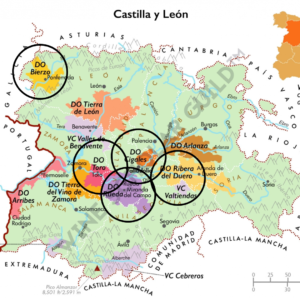
~ After getting all my notes, flashcards and charts together, I took a week and studied, studied, studied. Or should I say, Yo estudio mucho! Here was another reason why I recommend the instructor led program. While I was going over my notes, I had a few questions. Things I didn’t quite understand. I sent Rick an email and he answered each question within a few hours of me asking it.
The Exam
When I was ready to schedule the exam, I reached out the the Wine Scholar Guild. Rick had informed us that we needed to give at least 72 hours notice to taking the exam. If it was less than that there would be an additional fee incurred by the proctoring company. I received an email back within 24 hours with instructions on how to schedule the exam. I was able to pick whatever time and date I wanted. I chose a Saturday morning.

The exam is a 100 question multiple choice exam. It is done online through a program called Proctor U, and it is legit! I had to download a Chrome extension prior to taking the exam. When I logged in on the exam day, the extension allowed them access to my computer. My proctor made sure all tabs were closed on my computer and no other windows were open. He then had me move the computer around the room so that he could see where I was taking the exam. (he actually kicked my husband out of the kitchen, where he was having coffee) I needed to show him my driver’s license to prove who I was and use my phone selfie mode to show there was nothing stuck to my computer itself. He then asked me to push my sleeves up and show him my forearms and pick my hair up to show him my ears. Lastly, he made me take off my reading glasses and show them to him.
The proctor then informed me that he would be recording me and my screen during the entire exam. There was a chat box in case I had any questions or technical issues during the exam. He then instructed me that I could start the exam. I had one hour to complete the test. When I finished 40 minutes later, I opened the chat box and let him know I was done. He checked that he could see all my answers and told me to hit the submit button. And I was done.
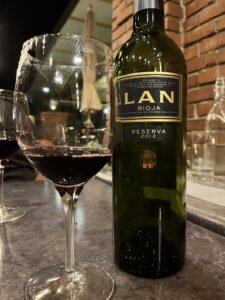 Now it was time to wait. It would be one week before I would know my results. That week was almost as stressful as the week I secluded myself to study. I decided I deserved a great dinner that night, so we went to a tapas house and opened a bottle of Bodegas Lan 2012 Reserva. My poor husband had to listen to me tell him what it meant to be Reserva and all the wonderful information I had learned about Rioja. He was a trooper!
Now it was time to wait. It would be one week before I would know my results. That week was almost as stressful as the week I secluded myself to study. I decided I deserved a great dinner that night, so we went to a tapas house and opened a bottle of Bodegas Lan 2012 Reserva. My poor husband had to listen to me tell him what it meant to be Reserva and all the wonderful information I had learned about Rioja. He was a trooper!
The following Friday, I received my results; Passed with Honors. About a week after that, I received my certificate and pin in the mail. We officially celebrated my SWS post-nominal with making a Tortilla Española and a beautiful Tempranillo a wonderful friend gifted me. (He had faith I would pass.)
Final Thoughts
I loved the program. Was it stressful? Yes. Did I torture myself? Yes. Was it worth it? Yes! I truly believe I have a much better understanding of the wines of Spain and the regions within the country. My ability to recognize the impact of terroir amplifies the wines I enjoy drinking. I look forward to being able to see more of Spain and experience the wines and the culture in person.
~Slàinte!
I invite you to follow me on Instagram, Twitter, Facebook and Youtube for all things wine. I’ll never tell you what to drink, but I’ll always share what’s in my glass.
Please support our sponsor:
Try the 90+ rated and multiple Double Gold medal winning wines of Dracaena Wines and get a 10% discount off your first order. Click the banner below and use code “Explore” at checkout. 